Creating unique pool and hot tub surrounds with composite materials
by jason_cramp | September 13, 2017 2:30 pm
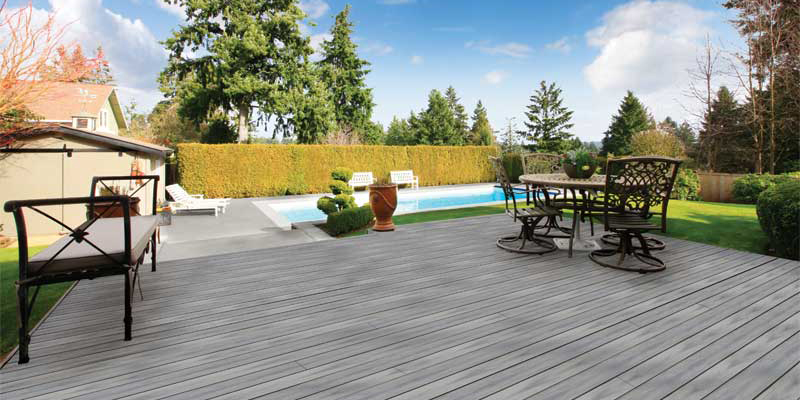 [1]
[1]When it comes to owning a pool or hot tub, as much as spending time in the water, homeowner enjoyment comes from relaxing on deck after a swim or soak. A pool and/or hot tub surround is a key part of the backyard experience, so choosing the right decking materials goes a long way toward boosting the clients’ satisfaction.
Next to concrete, wood decking had been the default material for building pool and hot tub surrounds and steps for many years. Recent advancements in materials science have seen more pool and hot tub builders/installers, as well as deck builders, using wood alternative decking products. One of the fastest growing among these is wood-plastic composites. Market researchers at Principia predict within the next few years composites and cellular PVC will represent 40 per cent of the total value of decking sold. As they explain, “the innovative products provide superior weathering properties, highly attractive esthetics, and low maintenance.”
Composite decking is beneficial for pool and hot tub applications, where its advanced features can enhance the outdoor living experience in several ways, including:
- Durability in wet environments;
- Comfort and safety;
- Beauty; and
- Ease of maintenance.
Durability in wet environments
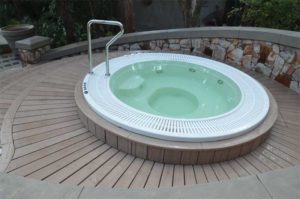
After investing thousands of dollars in a pool or hot tub, clients want assurance that their new amenities will last for years.
The high-moisture environment of pool and hot tub surrounds can be a challenge for decking. In addition to the damaging effects of sun and weather, surrounds face frequent wetting from playful splashing, people sitting on the deck in wet swimsuits, and water dripping off bathers as they climb out of the pool or hot tub.
Since the lifespan of a treated-wood deck is approximately 10 to 20 years, depending on the wood species, treatment, and the exposure, building professionals are increasingly specifying alternatives like composite decking to extend the life of their projects.
The engineering process of composites brings out the best qualities in the raw materials. Wood fibres contribute to strength and stiffness, while polyethylene plastics provide durability and moisture resistance. Although composites are generally more resistant to moisture than wood decking, composite brands vary greatly in their performance.
Composite products that have fully encapsulated wood fibres ensure quality, as this manufacturing process protects each board to the core. These products can be used in applications on or in the ground, as well as underwater without voiding the warranty. In cases where decay resistance is required, the National Building Code (NBC) of Canada permits the use of these composite materials, which makes them well suited for the high-moisture environments of pools and hot tubs.
In fact, many marinas across Canada, including British Columbia’s Kelowna Yacht Club, the Port of Orillia on Ontario’s Trent Severn Waterway, and Quebec’s Saint-Félicien Marina, have installed high-performance composites where moisture conditions are much higher than the typical backyard pool or hot tub.
Comfort and safety
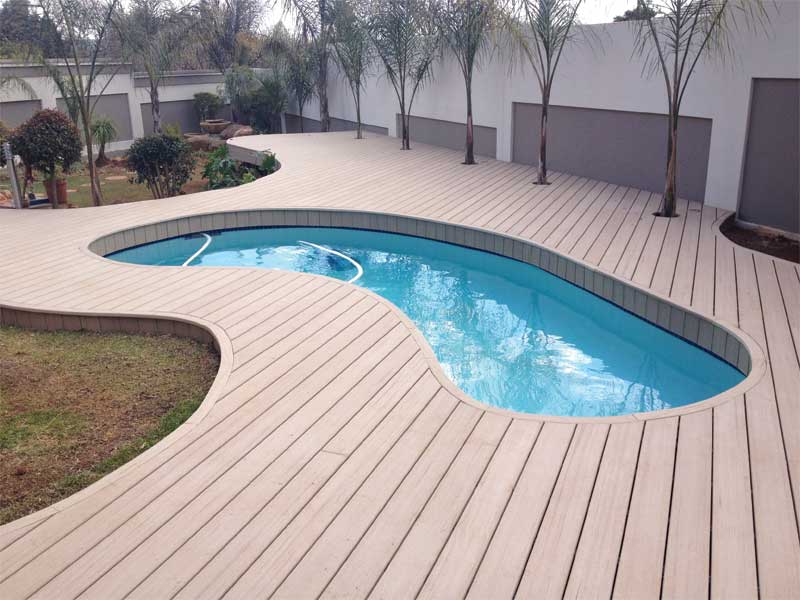 [2]
[2]Walking barefoot on a wood deck—especially one that has deteriorated from years of exposure—can result in painful splinters. Composite decking materials are splinter-free, so they provide a comfortable surface for walking, sitting, or lounging on.
With frequently wet surfaces, another important safety factor for decks near pools and hot tubs is slip resistance. Popular composites are not as slippery as wood decking, and have roughly the same coefficient of friction as smooth asphalt.
Another thing to consider when selecting deck materials is surface temperature. Dark-coloured decking, especially denser products, can become uncomfortably hot for bare feet when exposed to direct sun. To mitigate this in sunny climates, building professionals can specify lighter colour decking, including greys, tans, and similar hues. Some advanced composite boards even address this performance concern by optimizing heat reflection, so the boards absorb up to 35 per cent less heat than conventional capped composite boards in similar colours.
Beauty
For many homeowners, how good the decking looks is just as important as how well it performs. While many of the early composites were not as attractive as wood decking, modern composites offer a rich, warm look with realistic wood-grain details.
Embossing and colouring are two of the most distinctive beauty characteristics of composite decking. In the past, shallow wood-grain embossing and uniform colouring fuelled complaints about composites looking too much like plastic. With recent advances in technology, manufacturers have established ways to vary the colour tones of deck boards to resemble traditional wood. Purposefully designed with patterns that are more variable, today’s composite boards achieve the natural characteristics (i.e. colouring and grain) of wood deck boards.
Manufacturers have unique embossing patterns and techniques, which are increasingly more sophisticated. Deeper and more detailed embossing can catch light differently, better mimicking the random patterns of a wood deck board. Enhanced embossing also allows for easier cleaning and can help hide normal wear and tear.
| Tips for integrating pool and hot tub surrounds into the landscaping |
|---|
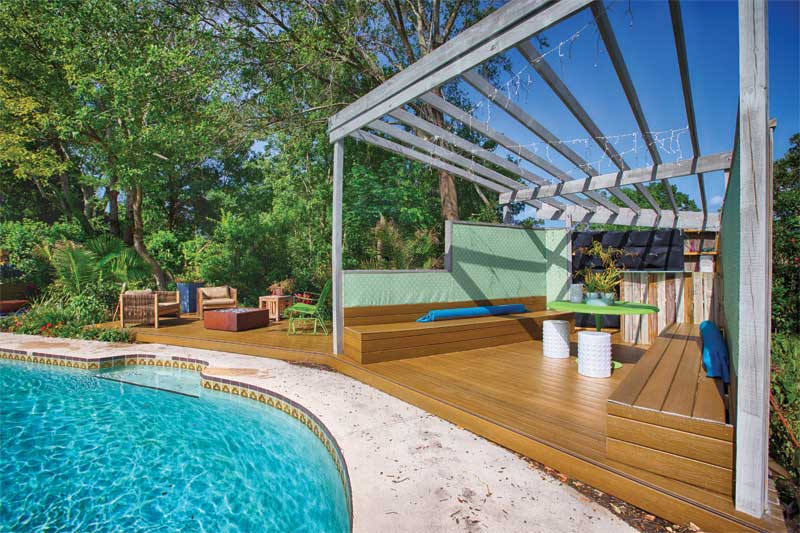 [3] [3]A powerful way to enhance a customer’s outdoor living experience is by adding a deck that integrates well, in form and function, with surrounding hardscape. From multi-level decks to those designed in complicated shapes, building professionals and homeowners are creating one-of-a kind pool and hot tub surrounds tailored to their personalities. The rise of deck accessories like specialty railing and lighting has opened the door even wider to creative outdoor spaces. A strong trend in deck design is the segmentation of separate smaller platforms. These ‘mini decks’ can be built in areas where a traditional deck might not fit, allowing for the use of every part of a backyard, even those with a strange shape or troublesome slope. Mini decks also work well as hot tub surrounds by providing another place to relax after a soothing soak. With better workability than wood, building around existing elements is easier with composite decking as it can be curved to encircle a tree or frame a garden, which helps provide continuity between deck and landscaping. Stairs provide another opportunity to enhance a deck’s design. Designs are almost limitless, as they can comprise chevron shapes, an elegant spiral, or wide, open stairway to provide visual interest while allowing safe and easy access to a pool and/or hot tub. |
| Enhancing deck design using lighting and railing |
|---|
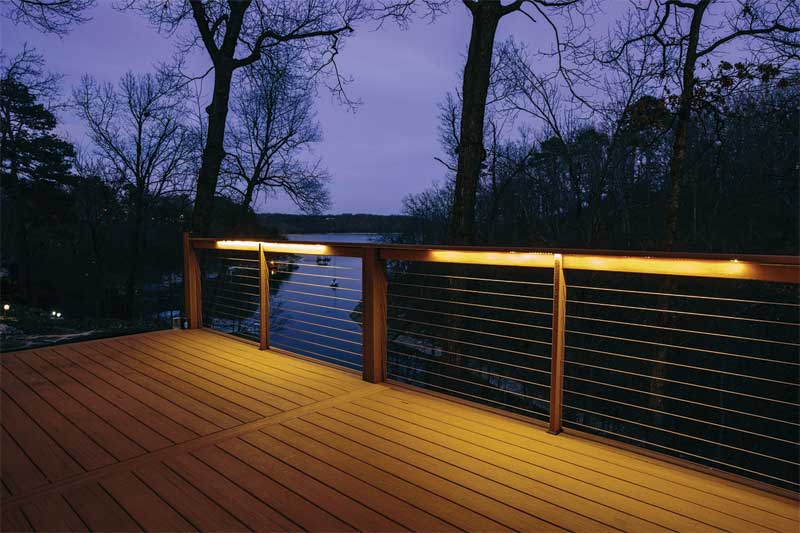 When it comes to adding a new deck or upgrading an existing one, savvy building professionals know attention to detail, such as railing and deck lights, can mean the difference between a simple backyard deck and an exceptional outdoor living space. Railing form and function Builders can start by choosing contemporary products like powder-coated aluminum or composite railings. Aluminum railing offers a sophisticated style and modern look at a more affordable price, and options with powder-coated finishes tend to provide longer warranties than other value rail options like vinyl. For homeowners and builders who prefer to mix-and-match the railing with the deck design, composite railing is a great option as it is available in a variety of colours and finishes. To further enhance a deck’s appearance, more builders are focusing on adding unique features and uses to the railing. Installing a rail in a wide width makes it convenient for guests to rest their drinks or elbows, which is great for entertaining. Using mixed medium infills such as cable or tempered glass panels can provide a high-end contemporary look. These visually open railings help connect the deck with the pool and other parts of the backyard. The options expand with deck lights Whether it is an evening entertaining guests or simply relaxing after a long day, deck lights can extend the hours homeowners enjoy their outdoor spaces. Today’s lighting options also add a touch of elegance, while enhancing safety. There are a variety of specialty deck lights available, including recessed bullet lights, under-rail strip lights, stair lights, and post lights. While this may sound overwhelming, or possibly even difficult to install, the emergence of energy-efficient light-emitting diodes (LEDs) has not only made installation easier, but has also improved overall performance, making design possibilities limitless. Plug-and-play systems are also available which help to eliminate the need for an electrician on the jobsite, simplifying the process for deck builders. These lights not only look great, they can also help streamline the product selection and installation process when they are compatible with the decking and railing installed. Some ideas for making the most of these options include installing button lights on the deck’s surface or on the top of the rail. This helps create a visual accent and enhances safety by providing deck users with important visual cues about the location of deck edges. When installed on top of wide rails, button lights provide visibility for people to use the rail as a resting place for drinks or plates of food—making the rail an ideal spot for nighttime socializing. Under-rail strip lights can also provide useful illumination and help define the deck, while creating intrigue by shining from a hidden fixture in an unexpected area. |
Ease of maintenance
One of the last things a pool and/or hot tub owner wants to do is spend a lot of time maintaining their deck. Ease of maintenance is one of the major factors accounting for the rapid growth in composites.
“Plastic and wood-plastic composite decking will grow the fastest [through 2018] based on their low maintenance requirements and long lifespans,” notes market research firm The Freedonia Group.
Unlike wood decking, composites do not need to be painted, stained, or sealed, which saves homeowners many hours in maintenance each year. Instead, composites typically only need regular sweeping to remove debris and an annual soap and water scrub to continue looking great.
Conclusion
Whether installing a standard hot tub or building a one-of-a-kind, specialty spa or pool, the surround is an important part of ensuring customer satisfaction. Today’s composite decking materials provide the moisture resistance, comfort, beauty.
 [4]Brent Gwatney is senior vice-president for sales and marketing at MoistureShield[5] composite decking. He has specialized in the building industry for more than 30 years, working with manufacturers, dealers, design professionals, contractors, and building officials. Gwatney can be reached via e-mail at brentgwatney@moistureshield.com[6].
[4]Brent Gwatney is senior vice-president for sales and marketing at MoistureShield[5] composite decking. He has specialized in the building industry for more than 30 years, working with manufacturers, dealers, design professionals, contractors, and building officials. Gwatney can be reached via e-mail at brentgwatney@moistureshield.com[6].
- [Image]: https://www.poolspamarketing.com/wp-content/uploads/2017/11/MoistureShield-MS_REFINE-1.jpg
- [Image]: https://www.poolspamarketing.com/wp-content/uploads/2017/11/MoistureShield-624.jpg
- [Image]: https://www.poolspamarketing.com/wp-content/uploads/2017/11/MoistureShield-113.jpg
- [Image]: https://www.poolspamarketing.com/wp-content/uploads/2017/09/Gwatney_Headshotx.jpg
- MoistureShield: http://www.moistureshield.com/
- brentgwatney@moistureshield.com: mailto:brentgwatney@moistureshield.com
Source URL: https://www.poolspamarketing.com/trade/creating-unique-pool-and-hot-tub-surrounds-with-composite-materials/